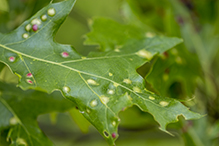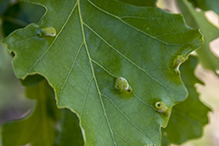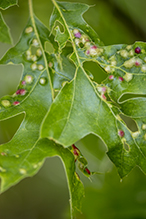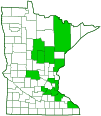Oak Leaf Blister
(Taphrina caerulescens)
Conservation • Description • Habitat • Ecology • Distribution • Taxonomy
|
|
|||||||||||||
Description |
Oak Leaf Blister is a common and widespread disease-causing (pathogenic) fungus. It occurs throughout the United States and in Quebec and Ontario. It infects about 50 species of oaks. The mold-like, asexual stage (anamorph) of the fungus is Lalaria coccinea. In this stage, the fungus is saprobic, obtaining its nutrients from dead and decaying organic matter. It overwinters in bark crevasses and bud scales. The sexually reproductive stage (telemorph) is Taphrina caerulescens. In this stage, it is parasitic, obtaining its nutrients from living tissue. In early spring it infects newly emerging leaves. It spreads its spores through wind and rain across the leaf surface and to other leaves. The fungus triggers an increase in the number of cells produced at the infection site. This appears as a gray, ⅛″ to ¾″ lesion on the underside of the leaf and a raised, up to ¾″ high, blister-like bulge on the upper surface. As the season progresses, the blisters may enlarge and merge, causing leaf curl and sometimes causing the leaf to drop. The damage to the tree is only cosmetic, rarely causing reduced overall growth. |
Similar Species |
Habitat and Hosts |
Cool, wet environments. Oaks. |
Ecology |
Season |
|
Distribution |
||
|
Sources |
|
| 6/12/2024 | ||
Occurrence |
||
Common and widespread |
||
Taxonomy |
|
Kingdom |
Fungi (Fungi) |
Subkingdom |
Dikarya |
Phylum |
Ascomycota (Sac Fungi) |
Subphylum |
Taphrinomycotina |
Class |
Taphrinomycetes |
Subclass |
Taphrinomycetidae |
Order |
Taphrinales |
Family |
Taphrinaceae |
Genus |
Taphrina (leaf curl fungi) |
Subordinate Taxa |
|
|
|
Synonyms |
|
Ascomyces caerulescens Ascomyces quercus Exoascus caerulescens Lalaria caerulescens Lalaria coccinea Taphrina quercus |
|
Common Names |
|
Oak Leaf Blister |
|
Glossary
Parasitic
Obtaining nutrients from another living organism.
Saprobic
A term often used for saprotrophic fungi. Referring to fungi that obtain their nutrients from decayed organic matter.
Visitor Photos |
||
Share your photo of this fungus. |
||
This button not working for you? |
||
|
||
|
||
MinnesotaSeasons.com Photos |
||
 |
 |
|
 |

Slideshows |
|

Visitor Videos |
||
Share your video of this fungus. |
||
This button not working for you? |
||
|
Other Videos |
||
|

Visitor Sightings |
||
Report a sighting of this fungus. |
||
This button not working for you? |
||
Robin Rainford |
Location: West St Paul, MN |
|
MinnesotaSeasons.com Sightings |
||

Created: Last Updated: © MinnesotaSeasons.com. All rights reserved. |
